Minghao Guo
LLM as GNN: Graph Vocabulary Learning for Text-Attributed Graph Foundation Models
Mar 05, 2025Abstract:Text-Attributed Graphs (TAGs), where each node is associated with text descriptions, are ubiquitous in real-world scenarios. They typically exhibit distinctive structure and domain-specific knowledge, motivating the development of a Graph Foundation Model (GFM) that generalizes across diverse graphs and tasks. Despite large efforts to integrate Large Language Models (LLMs) and Graph Neural Networks (GNNs) for TAGs, existing approaches suffer from decoupled architectures with two-stage alignment, limiting their synergistic potential. Even worse, existing methods assign out-of-vocabulary (OOV) tokens to graph nodes, leading to graph-specific semantics, token explosion, and incompatibility with task-oriented prompt templates, which hinders cross-graph and cross-task transferability. To address these challenges, we propose PromptGFM, a versatile GFM for TAGs grounded in graph vocabulary learning. PromptGFM comprises two key components: (1) Graph Understanding Module, which explicitly prompts LLMs to replicate the finest GNN workflow within the text space, facilitating seamless GNN-LLM integration and elegant graph-text alignment; (2) Graph Inference Module, which establishes a language-based graph vocabulary ensuring expressiveness, transferability, and scalability, enabling readable instructions for LLM fine-tuning. Extensive experiments demonstrate our superiority and transferability across diverse graphs and tasks. The code is available at this: https://github.com/agiresearch/PromptGFM.
Two-Stage Pretraining for Molecular Property Prediction in the Wild
Nov 05, 2024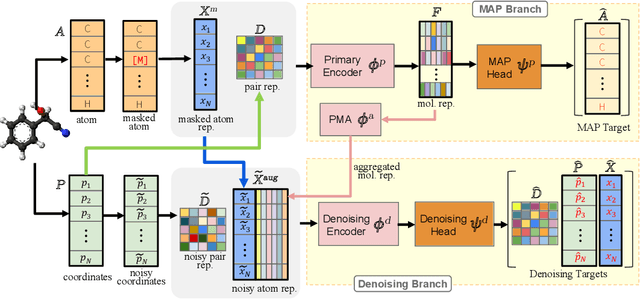

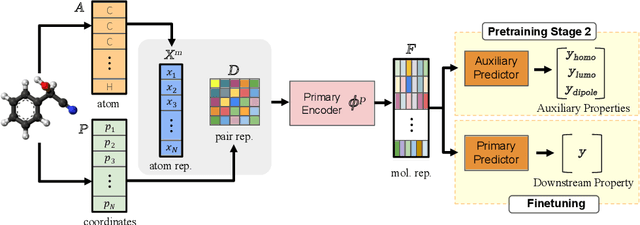

Abstract:Accurate property prediction is crucial for accelerating the discovery of new molecules. Although deep learning models have achieved remarkable success, their performance often relies on large amounts of labeled data that are expensive and time-consuming to obtain. Thus, there is a growing need for models that can perform well with limited experimentally-validated data. In this work, we introduce MoleVers, a versatile pretrained model designed for various types of molecular property prediction in the wild, i.e., where experimentally-validated molecular property labels are scarce. MoleVers adopts a two-stage pretraining strategy. In the first stage, the model learns molecular representations from large unlabeled datasets via masked atom prediction and dynamic denoising, a novel task enabled by a new branching encoder architecture. In the second stage, MoleVers is further pretrained using auxiliary labels obtained with inexpensive computational methods, enabling supervised learning without the need for costly experimental data. This two-stage framework allows MoleVers to learn representations that generalize effectively across various downstream datasets. We evaluate MoleVers on a new benchmark comprising 22 molecular datasets with diverse types of properties, the majority of which contain 50 or fewer training labels reflecting real-world conditions. MoleVers achieves state-of-the-art results on 20 out of the 22 datasets, and ranks second among the remaining two, highlighting its ability to bridge the gap between data-hungry models and real-world conditions where practically-useful labels are scarce.
Physically Compatible 3D Object Modeling from a Single Image
Jun 03, 2024Abstract:We present a computational framework that transforms single images into 3D physical objects. The visual geometry of a physical object in an image is determined by three orthogonal attributes: mechanical properties, external forces, and rest-shape geometry. Existing single-view 3D reconstruction methods often overlook this underlying composition, presuming rigidity or neglecting external forces. Consequently, the reconstructed objects fail to withstand real-world physical forces, resulting in instability or undesirable deformation -- diverging from their intended designs as depicted in the image. Our optimization framework addresses this by embedding physical compatibility into the reconstruction process. We explicitly decompose the three physical attributes and link them through static equilibrium, which serves as a hard constraint, ensuring that the optimized physical shapes exhibit desired physical behaviors. Evaluations on a dataset collected from Objaverse demonstrate that our framework consistently enhances the physical realism of 3D models over existing methods. The utility of our framework extends to practical applications in dynamic simulations and 3D printing, where adherence to physical compatibility is paramount.
TetSphere Splatting: Representing High-Quality Geometry with Lagrangian Volumetric Meshes
May 30, 2024Abstract:We present TetSphere splatting, an explicit, Lagrangian representation for reconstructing 3D shapes with high-quality geometry. In contrast to conventional object reconstruction methods which predominantly use Eulerian representations, including both neural implicit (e.g., NeRF, NeuS) and explicit representations (e.g., DMTet), and often struggle with high computational demands and suboptimal mesh quality, TetSphere splatting utilizes an underused but highly effective geometric primitive -- tetrahedral meshes. This approach directly yields superior mesh quality without relying on neural networks or post-processing. It deforms multiple initial tetrahedral spheres to accurately reconstruct the 3D shape through a combination of differentiable rendering and geometric energy optimization, resulting in significant computational efficiency. Serving as a robust and versatile geometry representation, Tet-Sphere splatting seamlessly integrates into diverse applications, including single-view 3D reconstruction, image-/text-to-3D content generation. Experimental results demonstrate that TetSphere splatting outperforms existing representations, delivering faster optimization speed, enhanced mesh quality, and reliable preservation of thin structures.
LLM and Simulation as Bilevel Optimizers: A New Paradigm to Advance Physical Scientific Discovery
May 16, 2024Abstract:Large Language Models have recently gained significant attention in scientific discovery for their extensive knowledge and advanced reasoning capabilities. However, they encounter challenges in effectively simulating observational feedback and grounding it with language to propel advancements in physical scientific discovery. Conversely, human scientists undertake scientific discovery by formulating hypotheses, conducting experiments, and revising theories through observational analysis. Inspired by this, we propose to enhance the knowledge-driven, abstract reasoning abilities of LLMs with the computational strength of simulations. We introduce Scientific Generative Agent (SGA), a bilevel optimization framework: LLMs act as knowledgeable and versatile thinkers, proposing scientific hypotheses and reason about discrete components, such as physics equations or molecule structures; meanwhile, simulations function as experimental platforms, providing observational feedback and optimizing via differentiability for continuous parts, such as physical parameters. We conduct extensive experiments to demonstrate our framework's efficacy in constitutive law discovery and molecular design, unveiling novel solutions that differ from conventional human expectations yet remain coherent upon analysis.
Representing Molecules as Random Walks Over Interpretable Grammars
Mar 13, 2024



Abstract:Recent research in molecular discovery has primarily been devoted to small, drug-like molecules, leaving many similarly important applications in material design without adequate technology. These applications often rely on more complex molecular structures with fewer examples that are carefully designed using known substructures. We propose a data-efficient and interpretable model for representing and reasoning over such molecules in terms of graph grammars that explicitly describe the hierarchical design space featuring motifs to be the design basis. We present a novel representation in the form of random walks over the design space, which facilitates both molecule generation and property prediction. We demonstrate clear advantages over existing methods in terms of performance, efficiency, and synthesizability of predicted molecules, and we provide detailed insights into the method's chemical interpretability.
Hierarchical Grammar-Induced Geometry for Data-Efficient Molecular Property Prediction
Sep 04, 2023Abstract:The prediction of molecular properties is a crucial task in the field of material and drug discovery. The potential benefits of using deep learning techniques are reflected in the wealth of recent literature. Still, these techniques are faced with a common challenge in practice: Labeled data are limited by the cost of manual extraction from literature and laborious experimentation. In this work, we propose a data-efficient property predictor by utilizing a learnable hierarchical molecular grammar that can generate molecules from grammar production rules. Such a grammar induces an explicit geometry of the space of molecular graphs, which provides an informative prior on molecular structural similarity. The property prediction is performed using graph neural diffusion over the grammar-induced geometry. On both small and large datasets, our evaluation shows that this approach outperforms a wide spectrum of baselines, including supervised and pre-trained graph neural networks. We include a detailed ablation study and further analysis of our solution, showing its effectiveness in cases with extremely limited data. Code is available at https://github.com/gmh14/Geo-DEG.
Adaptive Approximate Implicitization of Planar Parametric Curves via Weak Gradient Constraints
Feb 23, 2023Abstract:Converting a parametric curve into the implicit form, which is called implicitization, has always been a popular but challenging problem in geometric modeling and related applications. However, the existing methods mostly suffer from the problems of maintaining geometric features and choosing a reasonable implicit degree. The present paper has two contributions. We first introduce a new regularization constraint(called the weak gradient constraint) for both polynomial and non-polynomial curves, which efficiently possesses shape preserving. We then propose two adaptive algorithms of approximate implicitization for polynomial and non-polynomial curves respectively, which find the ``optimal'' implicit degree based on the behavior of the weak gradient constraint. More precisely, the idea is gradually increasing the implicit degree, until there is no obvious improvement in the weak gradient loss of the outputs. Experimental results have shown the effectiveness and high quality of our proposed methods.
Data-Efficient Graph Grammar Learning for Molecular Generation
Mar 15, 2022



Abstract:The problem of molecular generation has received significant attention recently. Existing methods are typically based on deep neural networks and require training on large datasets with tens of thousands of samples. In practice, however, the size of class-specific chemical datasets is usually limited (e.g., dozens of samples) due to labor-intensive experimentation and data collection. This presents a considerable challenge for the deep learning generative models to comprehensively describe the molecular design space. Another major challenge is to generate only physically synthesizable molecules. This is a non-trivial task for neural network-based generative models since the relevant chemical knowledge can only be extracted and generalized from the limited training data. In this work, we propose a data-efficient generative model that can be learned from datasets with orders of magnitude smaller sizes than common benchmarks. At the heart of this method is a learnable graph grammar that generates molecules from a sequence of production rules. Without any human assistance, these production rules are automatically constructed from training data. Furthermore, additional chemical knowledge can be incorporated in the model by further grammar optimization. Our learned graph grammar yields state-of-the-art results on generating high-quality molecules for three monomer datasets that contain only ${\sim}20$ samples each. Our approach also achieves remarkable performance in a challenging polymer generation task with only $117$ training samples and is competitive against existing methods using $81$k data points. Code is available at https://github.com/gmh14/data_efficient_grammar.
Polygrammar: Grammar for Digital Polymer Representation and Generation
May 05, 2021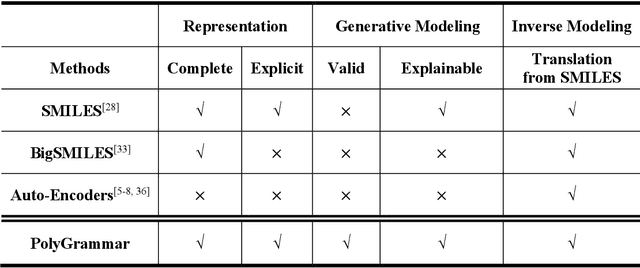
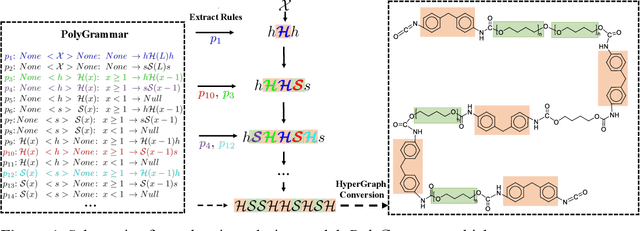
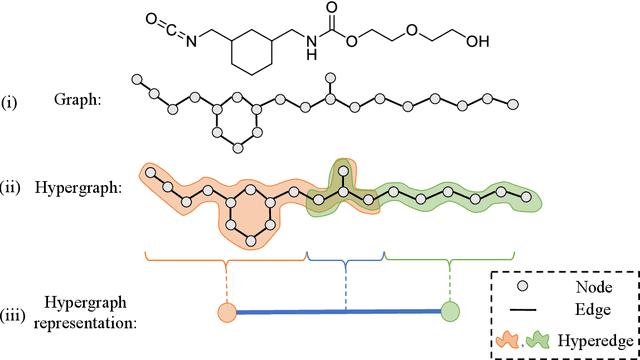
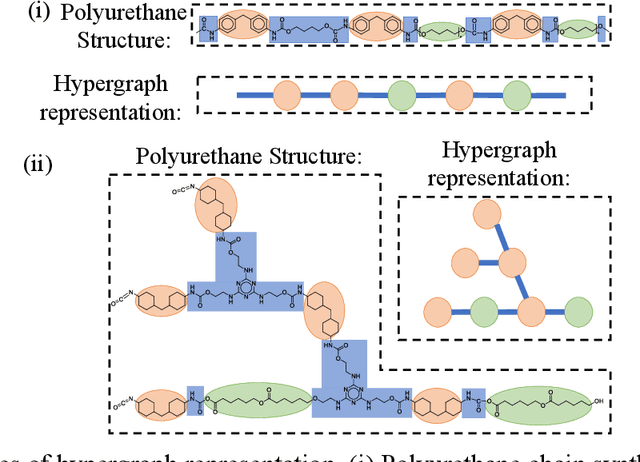
Abstract:Polymers are widely-studied materials with diverse properties and applications determined by different molecular structures. It is essential to represent these structures clearly and explore the full space of achievable chemical designs. However, existing approaches are unable to offer comprehensive design models for polymers because of their inherent scale and structural complexity. Here, we present a parametric, context-sensitive grammar designed specifically for the representation and generation of polymers. As a demonstrative example, we implement our grammar for polyurethanes. Using our symbolic hypergraph representation and 14 simple production rules, our PolyGrammar is able to represent and generate all valid polyurethane structures. We also present an algorithm to translate any polyurethane structure from the popular SMILES string format into our PolyGrammar representation. We test the representative power of PolyGrammar by translating a dataset of over 600 polyurethane samples collected from literature. Furthermore, we show that PolyGrammar can be easily extended to the other copolymers and homopolymers such as polyacrylates. By offering a complete, explicit representation scheme and an explainable generative model with validity guarantees, our PolyGrammar takes an important step toward a more comprehensive and practical system for polymer discovery and exploration. As the first bridge between formal languages and chemistry, PolyGrammar also serves as a critical blueprint to inform the design of similar grammars for other chemistries, including organic and inorganic molecules.
 Add to Chrome
Add to Chrome Add to Firefox
Add to Firefox Add to Edge
Add to Edge